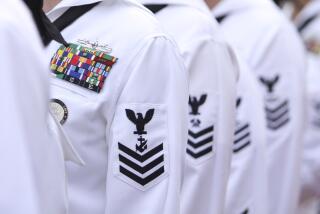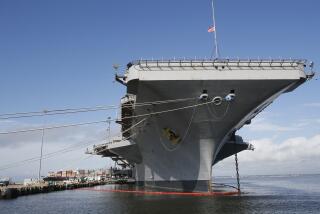Nemesis Experts Keep Navy’s Secret Weapons Shipshape
- Share via
PORT HUENEME — Behind two barbed-wire fences on the Port Hueneme naval base lies a secretive brain trust of engineers, scientists and other trouble-shooters who keep the Navy’s most sophisticated weaponry prepared for war.
At any time, several hundred of these Navy employees--all civilians--are scattered aboard ships throughout the globe to ferret computer glitches or other malfunctions of shipboard guns, radar, missile-guidance controls or launchers.
If the Middle East crisis escalates into war, teams of engineers and technicians are poised to depart at a moment’s notice to any of the 55 U.S. warships in the Persian Gulf region.
“We normally don’t have flyaway teams ready, except when there is a potential for a shooting war,” said R.T. (Ted) Rains, technical director of the Naval Ship Weapon Systems Engineering Station at Port Hueneme. “We have been told to go into a higher state of readiness.”
The Navy’s engineering station is called Nemesis, a name coined out of the acronym for the station’s original name--Naval Ship Missile Systems Engineering Station.
Since its inception in 1963, the station’s role has expanded, and its official name has changed. Yet, the nickname stuck. Throughout the fleet, it is still Nemesis, after the Greek mythological goddess of vengeance.
With an annual budget of $275 million, Nemesis is one of the largest employers in Ventura County. In addition to 2,300 civilian and 100 military employees on the base, Nemesis contracts with defense firms for an additional 2,100 employees. About 70% of those workers are in the area.
Nemesis provides a variety of services to the U.S. fleet. It is best known for its technical experts who help design shipboard weapons, install them, test them and fix them when they break down.
“We are not the Maytag repairman, although we do some of that kind of business,” said Capt. Rick Williams, Nemesis’ commanding officer. “We are more the Maytag engineer or designer.”
When technical glitches befuddle other naval engineers, the fleet turns to Nemesis for technical expertise.
ome technicians travel eight months of the year, typically jetting out of Los Angeles International Airport on short notice en route to a ship with crippled weapons. The technicians usually arrive by helicopter, Navy officers said, sometimes lowered by a harness if a chopper has no place to land.
“When they drop out of the sky, it’s like manna from heaven,” said Capt. Robert O. Crawshaw, assistant chief of staff for combat systems aboard the 188 ships in the Navy’s Atlantic Fleet.
“When it gets to the Nemesis level, our super technicians have spent a lot of frustrating hours working on the problem,” Crawshaw said. “These guys have a certain aura about them. You know, if they can’t fix it, it can’t be done.”
The Atlantic Fleet, centered in Norfolk, Va., has eight Nemesis teams deployed throughout the world, “fixing electronics and coming up with software patches for computer programs,” Crawshaw said. The Pacific Fleet makes similar use of them.
In one celebrated example in 1987, Navy officers called in a Nemesis team to handle the delicate task of unloading 39 Standard and Harpoon missiles from the U.S. warship Stark after it was crippled by an Iraqi Mirage jet fighter.
The Iraqi jet had struck the Stark with two Exocet missiles, killing 37 sailors and starting a fire that “cooked” part of the deck and disabled the fully loaded missile launcher.
Fortunately, the Stark’s crew had turned hoses on the missiles to cool them down, said Capt. Robert L. Wilson, who led the Nemesis team from Port Hueneme to the frigate anchored in the Persian Gulf near Bahrain.
The team worked double shifts in 110-degree heat moving the missiles, each weighing nearly one ton, onto another ship for safekeeping. The Stark had lost power, so Nemesis team members had to use a hand crank on the launcher to move the missiles into position for removal, Wilson said.
“It is roughly 20 turns per inch,” he said. “We did it in about two weeks total time.”
For the most part, Nemesis work does not involve heavy lifting. Capt. Earl Major, Nemesis’ chief engineer, estimates that 95% of the problems that crop up with today’s sophisticated weaponry involve computers or electronics.
Nor do Nemesis employees usually perform their jobs under the threat of attack. Much of the routine work goes on at port or on sea trials.
Nevertheless, Nemesis teams spent a great deal of time aboard U.S. warships in the Gulf of Tonkin during the Vietnam War. As soon as President Bush ordered the buildup of U.S. forces in the Middle East, Nemesis managers collared the few hundred employees most likely to be needed.
“All of those people have been briefed and gotten their passports,” Williams said. “They wouldn’t go en masse. They would go in ones and twos, to respond to problems as they arise.”
Now, only a few Nemesis employees are aboard ships in the Middle East, Nemesis officials said. Some have gone, performed their jobs and returned. For security reasons, all details are classified as secret.
Nemesis officials say some activities are classified because the Navy does not like to reveal the location of warships. More significant, many Nemesis personnel work on secret weapon technology.
Adding to the cloak of secrecy is the extra fence and tighter security that separates the station from its landlord at Port Hueneme, the surrounding Naval Construction Battalion Center, or Seabee base.
“We have more secret material than the Seabees do,” Major said. “Most of the Seabee stuff is moving a mound of dirt or putting up light poles. A lot of what we do is classified.”
Even beyond the fence, only select Nemesis employees are allowed access to the Eli T. Reich Surface Warfare Engineering Facility. The building houses the bulk of the computers, duplicates of those on warships used to launch and guide missiles and fire other weapons.
Some sections require higher security clearance. Each employee has an identification card that must be approved by an electronic scanner before certain doors will open. Windowless computer rooms are encased with steel doors to prevent electronic signals from escaping where they might be picked up by enemy eavesdroppers.
“Of course, a lot of the work we do and the equipment we handle is super-secret stuff,” said Russell M. Pyle, Nemesis’ longtime public affairs officer. “You could live next door to a Nemesis engineer and never know what he does. It’s not something he can bring up at a cocktail party.”
Nemesis engineers work closely with the developing combat technology aboard Aegis cruisers, the Navy’s newest class of warships expected to carry the fleet for the next 40 years.
Other weapons date back to World War II and require “a lot of hand-holding,” said Tavy Cain, manager of the cruise weapons department. “Some are so old there are only a handful of people who understand how they work,” he said. “That’s where we come in.”
The Navy established Nemesis to maintain increasingly complex weapons with its own staff of engineers and technicians. As the weaponry has grown more sophisticated, so has Nemesis.
In addition to trouble-shooting, the station trains uniformed Navy technicians, maintains 230,000 technical manuals and keeps track of millions of spare parts. One section of Nemesis is devoted to replenishing ships at sea with weapons and other goods.
The Navy selected Port Hueneme for Nemesis because of its deep-water port, which allows Navy vessels to sail on base, and its proximity to the Pacific Missile Test Center at Point Mugu, one of the few Navy facilities for testing missiles fired by Navy jets.
Unlike the test center, Nemesis deals solely with weapons fired from surface ships. It routinely sends teams of engineers on ships cruising into the wide expanse of the Pacific Missile Test Range to test missiles and other weapons.
“We are fortunate to have Point Mugu so close by,” Major said. “We fire a lot of missiles on the range.”
More to Read
Sign up for Essential California
The most important California stories and recommendations in your inbox every morning.
You may occasionally receive promotional content from the Los Angeles Times.













